Helen Young and I have talked all about organic matter a few times at garden shows. For those who haven’t got to see/hear us, (and those who were too enthralled to take notes) here’s a text version of our talk. It’s a long blog post (we talked for about 30 minutes) but that’s what it takes for even an introduction to this essential gardening topic as we cover the why, what, which, when, how, of organic matter in the garden, and some important cautions about using too much or when you shouldn’t use it at all.

Helen Young and I get ready for some OMG
Everyone recommends adding organic matter to improve your soil. But what does that mean? Have you ever seen a bag labelled ‘organic matter’ for sale?
What exactly is organic matter (OM)?
When we say ‘organic’, it doesn’t mean the same thing as when you’re talking about organic food, or organic gardening. Organic matter in the garden means the part of the soil that’s not mineral. Organic matter has come from something that was, or is, alive so it has carbon as its main building block. So soil organic matter means things like decayed plants, micro-organisms and animals, as well animal manures – which of course, came originally from plants too.
Organic matter in soil does 5 main things to improve your soil:
1. it’s a source of nutrients for plants. As organic matter like decaying plants is broken down by soil organisms, it forms humus, which is that fine, dark coloured layer you often find right near the top of your garden soil. Plant nutrients can stick on to this humus and then be slowly absorbed by plant roots.
2. organic matter holds water. Organic matter acts like a sponge in the soil. Like a sponge, it can absorb and hold on to water that would otherwise drain away, so that it’s there for the plant’s roots. But at the same time, also like a sponge, the bigger spaces in the organic matter refill with air as excess water drains away, so that the plant roots can breathe as well.
3. organic matter builds soil structure, which means how the soil is held together. A good soil is sort of crumbly and a rich, dark colour. It’s not just sandy grains, or one massive block of clay. Organic matter binds sand or clay particles together into bigger crumbs. And like the sponge we were talking about before, a soil rich in organic matter bounces back so it doesn’t become compacted. And soils that stick together in crumbs, also stay together better and don’t get washed or blown away.
4. organic matter adds a brew of all the soil microbes that are feeding and working away on decomposing the organic matter. Just like probiotics for humans, we now understand that these are good bacteria and fungi, which can make plants more resistant to disease.
5. organic matter helps regulate soil temperature. Soils that are low in organic matter can become much hotter or colder.
 WHY WOULD YOU ADD OR USE ORGANIC MATTER?
WHY WOULD YOU ADD OR USE ORGANIC MATTER?
Doesn’t your soil already have enough organic matter in it? Natural soils throughout the world usually have about 3-5% organic matter and most plants are adapted to growing well in this range. But many Australian soils have only 1-2% organic matter, so you’ll need to add more OM if you want to:
– grow plants from outside your local area
– garden more intensively, with plants spaced closely together
– grow plants that need a lot of nutrients, like vegetables and fruit trees
Amazingly, OM improves all types of soils. Whether you’re near the coast and your soil is more like pure sand than soil or you’re further inland with heavy clay, OM improves the water- and nutrient-holding capacity of both these extremes, enriching sandy soils, and opening up clay soils.
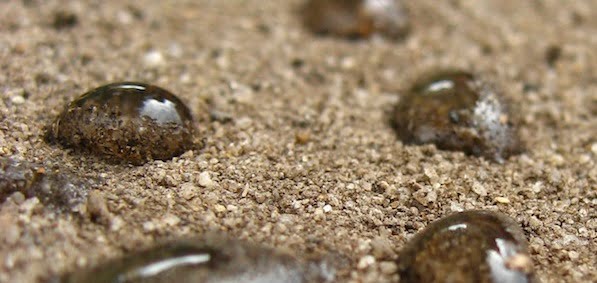 There is a caution about mixing OM with sandy soils. Yes, it can help improve your soil, but organic matter is also quite sticky and waxy, and it can make sandy soils more water repellent which means it’s hard to water as it runs straight off and won’t soak in. Eventually they’ll start to improve but to start off you should include a humus-based wetting agent. In Australia, you can buy products like Eco-hydrate from Organic Crop Protectants or Seasol Soil Wetter and Conditioner.
There is a caution about mixing OM with sandy soils. Yes, it can help improve your soil, but organic matter is also quite sticky and waxy, and it can make sandy soils more water repellent which means it’s hard to water as it runs straight off and won’t soak in. Eventually they’ll start to improve but to start off you should include a humus-based wetting agent. In Australia, you can buy products like Eco-hydrate from Organic Crop Protectants or Seasol Soil Wetter and Conditioner.
So your plants don’t just need fertilisers. It’s what many gardeners mean when they say:
‘feed the soil, not the plant’
While you can add fertiliser to give your plants essential nutrients, they’re going to miss out on all the other benefits that come with a healthy soil that’s rich in organic matter. It’s a bit like humans living on vitamin pills instead of fresh food – you’ll get the nutrients but miss out on all the other essential goodies for a healthy body. So, here’s the bottom line. Even if you don’t remember all the science, it’s clear that organic matter has so many benefits you’d be mad to garden without it. Magic? We think so!
WHAT CAN YOU USE TO ADD ORGANIC MATTER TO YOUR SOIL?
We already mentioned about how you can’t find packages labelled ‘Organic Matter’ at the shop. So what can you use to add it to your soil? The short answer is loads of things. Let’s look first at things you can make yourself by recycling and at low cost – compost, worm castings, leaf mould and green manure.
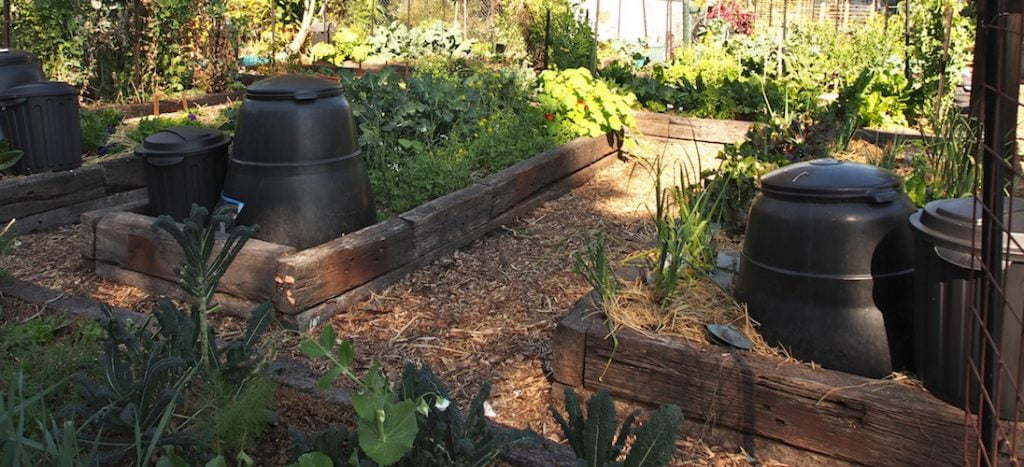
Compost bins in a community garden
Recycled organic matter from your garden
Compost, a good garden’s ‘magic ingredient’, is basically a load of waste products turned into the most valuable tool in the garden, and all for free. Making compost is a whole blog post or even book on its own, but the most important thing is to just have a go at it, whether it’s burying your kitchen scraps in the garden, using a Bokashi bucket in the kitchen, shredding your prunings into a compost tumbler, or having a fancy 3-bay rotating system. Don’t throw stuff out in a green-waste bin, compost it! And there’s good science behind this – did you know that trials by NSW DPI showed adding compost can produce the same harvest weight of vegetables as standard fertiliser application, but without the run-off of nutrients, using less water and at a lower cost?
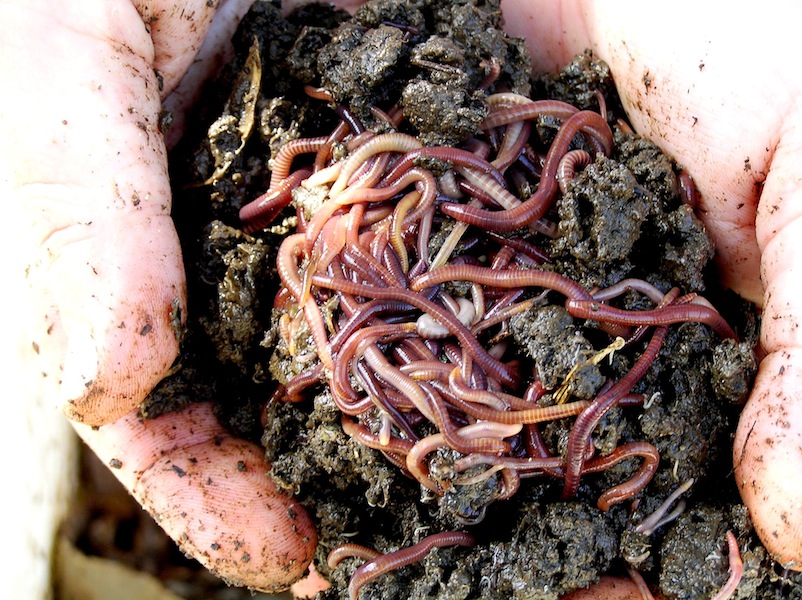
Compost worms
Worm castings, or vermicast, is just a polite name for worm poo, which you harvest from your worm farm. It’s what you get after food scraps pass through the worm’s cool-temperature digestive tract, picking up thousands of good bacteria and fungi which help plants take up nutrients. It has an earthy, inoffensive smell and contains trace elements, and minor amounts of nutrients. Apply small handful of castings around seedlings, mix a handful in potting mix per pot, or add a couple of handfuls per square metre to garden beds. You can also use worm ‘tea’ which is liquid drained from the worm farm, diluted to the colour of weak tea.
Leaf mould is another great example of turning a problem into a benefit. Just rake up piles of autumn leaves, wet them down, shove them in large garbage bags with some holes for air and leave to rot down. You can mow them over first to break them up. Oak leaves make excellent leaf mould. And it’s not mouldy at all despite the name. It smells rich and earthy and is a valuable addition to your garden.
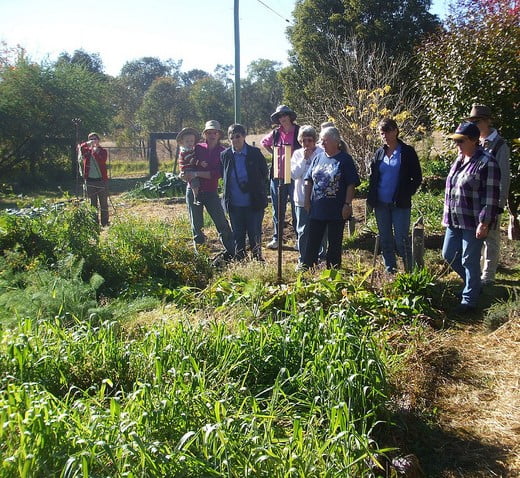
Green manure crop growing in Barbara Tenne’s Coonabarrabran permaculture garden. Photo Vivian Evans
Green manure is the term for sowing a crop of certain seeds, letting them grow to the point of flowering and then digging them into the soil. As the green leafy material is broken down and decayed by soil microorganisms it adds some nitrogen back into the soil. Green manure crops have always been a traditional part of a crop rotation system in market gardening and home vegetable gardening and they’re a low-cost way to improve large areas for new garden beds. Examples are legumes including cowpeas, lucerne, various beans like mung bean, soy bean, fava beans, field peas or lupins, or grasses like buckwheat, oats, and annual ryegrass. In Australia you can buy green manure seed kits from Green Harvest, and Greenpatch Organic Seeds.

Animal manures – if you keep your own chickens, goats, cattle, sheep, horses (even guinea pigs!) you’ve got access to a wonderful organic matter resource for your garden but you shouldn’t ever use it fresh. Collect it, cover or bag it, and leave it to mature over several months, or add it to your compost. You can put collected cow pats through your chipper, which pulverises them nicely.
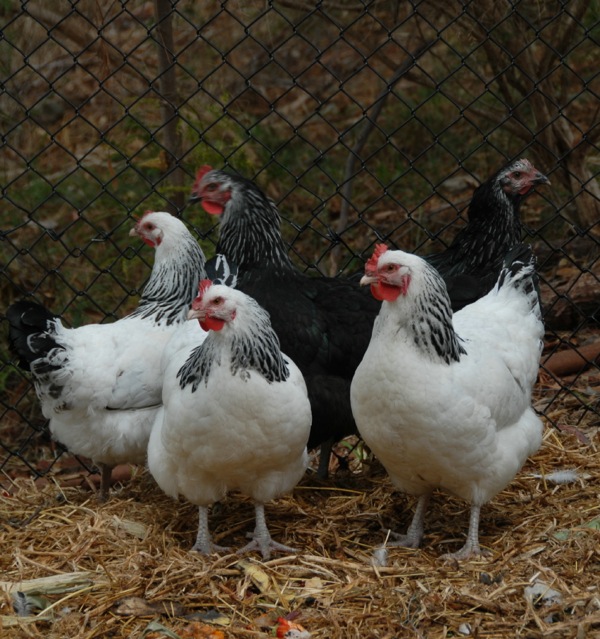
Backyard chooks. Photo Helen McKerral
Poultry and bird manure is very concentrated and must be composted until there’s no strong ammonia smell left. It can be alkaline because of a high calcium content, and can also be high in phosphorus, so use it sparingly near plants that are phosphorous sensitive, like many Australian native plants. Cow manure from grass-fed beasts is comparatively low in nutrients. Because cattle are ruminants, most weed seeds will have been cooked out of existence, although you might pick up some with the pat! Horse manure is likely to have viable weed seeds in it, as they’re not ruminants. (See more on bought bagged manures below)
Organic matter to buy in bags at garden centres, or outside farms, or in bulk
Manures in bags are readily available, from all sorts of beasts and birds. They vary in nutrient content from not much to lots, so it’s line-ball whether you regard these as soil conditioners or fertilisers. Manure from cows, horses, sheep, alpacas etc are all quite mild and fairly low in nutrients, and are good sources of organic matter. Bear in mind if you buy bagged manure from the roadside you might get weed seeds in it. You might also want to find out how the animals were kept, including drenching with antibiotics or worming medications. Bagged horse manure from the stable is usually mixed with bedding straw and bagged sheep manure mixed with urine from the shearing shed, sale pen or abattoir, giving it added nitrogen. Poultry manure is usually sold as chook poo pellets but these are concentrated, so they’re really fertilisers rather than just OM. Pigeon manure has been used for centuries and is also high in nutrients (14 times higher than cow manure) as the birds are fed nutrient-dense grains and seeds. Cow manure sourced from feedlots is much higher in nitrogen and zinc than that from paddock-raised animals, and is also saltier.
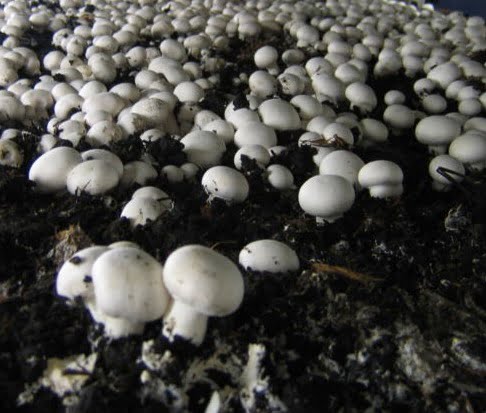
Mushroom farm Photo Andrew Bossi
Mushroom compost is the spent compost from mushroom farms after the mushrooms are harvested. You need to be careful with it as it can be very alkaline from the high calcium content, and possibly also salty from high nutrient content. So don’t use it on acid-loving plants ie natives from Australia’s east coast, camellias, azaleas, rhododendrons. But it’s good to add for some vegies such as peas, onions, asparagus, and also for roses or if your soil is too acidic. The tip here is to check your soil pH before using it.
Cocopeat and peat – cocopeat, or coir, is the fibre from the outside of the coconut. It is now used as a substitute for real peat from peat bogs, which is environmentally unsustainable. They have similar qualities, increasing the water and nutrient holding capacity of your soil. Cocopeat comes in compressed blocks or bricks that you soak in water. It rewets easily so it’s useful if you’ve got soil that tends to be a bit water repellent, like many sandy soils can be.
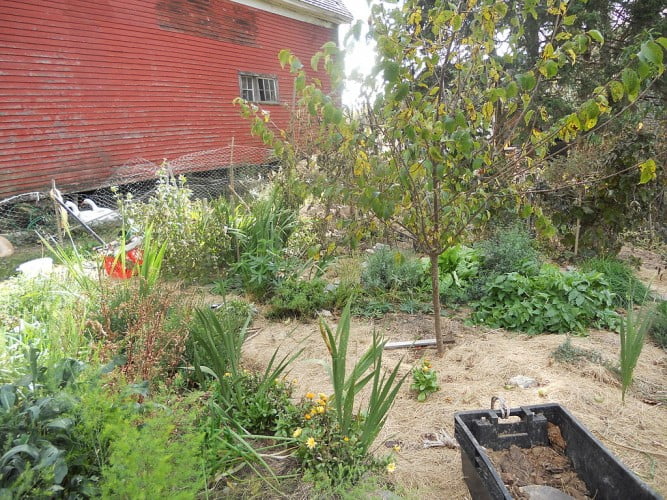
Permaculture garden with a fruit tree, herbs, flowers and vegetables mulched with hay Photo Gandydancer
Soft mulches – sugar cane, pea straw, lucerne, hay and straw mulches break down fairly quickly, feeding the soil. It’s really worth using soft mulches around productive plants such as vegetables and fruit trees, and around flowering plants such as roses and annuals. Lucerne is particularly good for plants according to tests by CSIRO, as it’s high protein content feeds bacteria. Pea straw and lucerne are legumes so they also contribute some nitrogen to soil. Caution – hay and lucerne often contain weed seeds or own seeds, although they’re easy to pull out.
Compost in bags – bags labelled ‘Compost’ or ‘Planting Compost’ have been made from a wide range of ingredients, including composted green waste, composted pinebark fines, mushroom compost, manures and also contain other additives, like fertiliser and gypsum. Our advice is to check the ingredients before you buy. You can also but some compost mixtures in bulk from landscape suppliers, which is a much more economical way to buy than bags if you are improving large areas of garden beds. Many are made from composted green waste. An example for sale in Sydney is ‘Re-carb Essence’ – 100% organic compost from ANL, but you can also buy mixes such as ‘cow and compost’, which is 50% cow manure and 50% compost.
 WHICH ORGANIC MATTER SHOULD YOU PICK?
WHICH ORGANIC MATTER SHOULD YOU PICK?
Our advice is to use several of these ingredients, not just one. Variety is good – whether it’s a fruit salad you’re making, or a healthy garden. Your first and best choice is to recycle nutrients from your own place with compost, worm farms, green manure crops, keeping your own chooks, and making leaf mould. You know what’s gone into it, it’s free, and it doesn’t need to be transported. You second choice should be to buy local where possible, which saves transport costs, is cheaper, and supports local businesses.
You might also think about the source, such as do you want only organic inputs to your garden? Bagged cow and chook manure has been harvested from feedlots, abattoirs and intensive chicken sheds, so if you choose not to buy products of that farming style to eat, you may prefer not to buy them to use on your garden either.
WHEN DO YOU ADD ORGANIC MATTER, HOW, AND CAN YOU ADD TOO MUCH?
WHEN: Adding organic matter is not a once-off thing, it’s something you need to do on a regular basis. Even if you’ve added some organic matter to your soil in the past, you need to do it again, because organic matter gets used up. Whatever you put on your garden today, two thirds of it will have been used up by soil flora and plants within ONE year. When you see your plants growing well, they’re doing that by using up organic matter that’s in the soil. When you prune your plants, and take away those clippings, you’re removing OM. In fact, leaving those stems and leaves on the soil surface to decay would add some OM back in.
In sandy soils, OM gets used up even faster because it’s more exposed to air so everything decays faster. If you like to dig your soil over regularly, that also exposes OM to air so it disappears more quickly, and if you water your garden a lot, you’re washing it away as well.
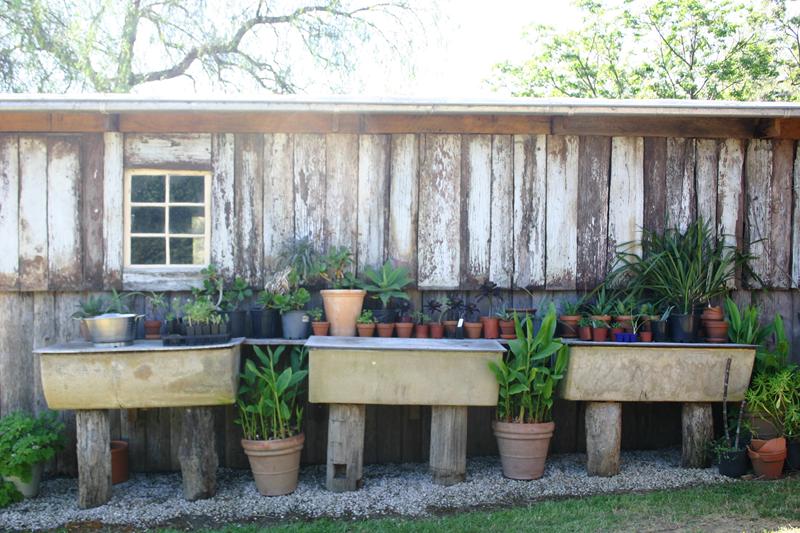
Potting up area.
A special case – potting mix
We’ve talked a lot about OM in garden soil, but the potting mix you buy also has lots of OM in it that also gets used up. Have you ever filled a pot or trough with potting mix, planted your plants and then noticed about 6 months later that the level of the mix has slumped by several centimetres? Some of that is the initial settling down of the mix, but some is also the OM in the mix being used up by the plants. The potting mix becomes light and crumbly, and no longer holds much water or nutrients. It’s often described as ‘spent’.
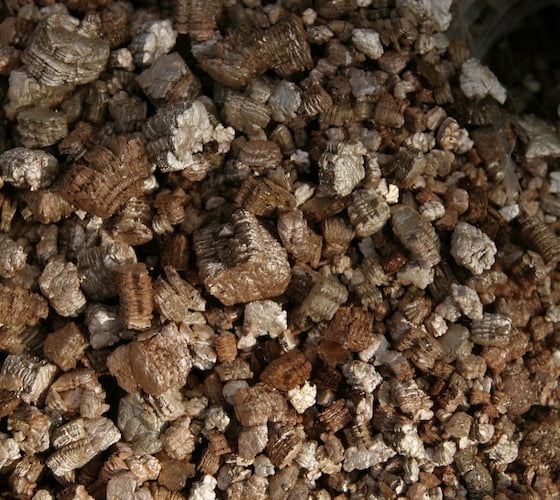
Vermiculite
Apart from the pot becoming filled up with plant roots, it’s one of the reasons that you should repot your plants every year or two, even if it’s just back into the same pot. You can also add a centimetre or two of fresh potting mix or compost to the top of the pot every 3-4 months. Another way to deal with the problem is to add stuff to the potting mix before you use it. Mineral additives like vermiculite, perlite and zeolite also hold onto water and nutrients but don’t get used up like OM.
HOW DO YOU ADD ORGANIC MATTER?
1. Existing garden beds with plants Add a layer 1-2cm (that’s a bit less than an inch) but don’t dig it in. Let water, earthworms and microbes do their things – they’ll do all the mixing for you and you won’t damage your soil profile or plant roots by digging. If your garden is mulched, just scrape back the mulch, spread your OM, then put the mulch back over the top.
2. Preparing new beds The ideal time to add OM to new beds is before planting to improve the soil. If you want to really change your soil structure, you’ll need to add 5-8cm (that’s 2 or 3 inches) and incorporate it through the top 20cm (or 8 inches). And use OM to improve your existing soil rather than buying in new ‘made’ soil. Bought soils are better than they were a few years ago before there was an Australian Standard, but they’re still not a patch on improving your natural site soil, whether it’s sandy or clayey. Bought soils are usually missing a key ingredient – clay. It’s too heavy and impractical to use it in man-made soils, so lots of organic matter is added instead, as nutrients only stick on to either clay particles or organic matter. But we know OM gets used up, and lots of it can have its own problems. It’s a lesson to learn that it’s always better to work on gradually improving the soil you’ve got, rather than get rid of it and buy new stuff because you think that will be better. But adding OM is not always so simple….
CAUTIONS
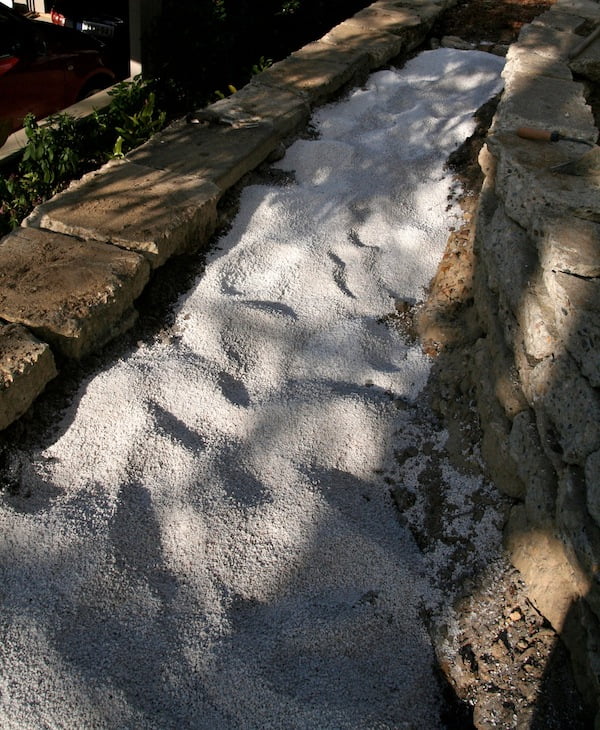
Improving clayey subsoil in a raised garden bed with perlite and vermiculite
1. Filling deep gardens beds If you’re filling in behind retaining walls or a deep planter box on a balcony, or even a raised vegie bed, all cases where the depth of new soil is quite deep, these are special circumstances that need some understanding. Organic matter needs oxygen to decompose, so the part of the soil profile that’s deeper than 200mm (8 inches) needs to be free of organic matter as there’s very little oxygen below that depth. If you put OM down there, it will suck every bit of oxygen out of the surrounding soil as it tries to decompose, causing plant roots to die.
Understanding this is also important when you are planting new trees. You don’t want to put manure or compost at the bottom of the planting hole. Down deep it won’t have the necessary oxygen to decompose and can even go foul, causing damage to your new tree’s roots. Keep the OM in the top layers. Deeper soils can only be improved with mineral additives, like zeolite, vermiculite and rock dusts. These have lots of important properties and can hold on to nutrients too but because they are minerals, they don’t decompose.
2. Can you ever add too much organic matter? The answer is yes, you certainly can.
If you’re pumping your soil full of OM every few weeks, you’re definitely overdoing it and your garden will probably become a soggy mess. You could go for little and often, like a watering with worm tea, or think about adding OM seasonally or, in colder climates, twice a year in early spring and again in mid-summer when plants are growing the most.
Bought soils can be so high in organic matter that if you add more, it’s as if you’ve added huge doses of fertilisers to your soil – they can end up with a high salt content and very high levels of some nutrients that plants only like a tiny taste of, like boron. By adding too much OM you also risk the soil holding too much moisture so the roots end up rotting. So if you’ve bought a load of quality new soil, you don’t need to add any more OM. There is a new Australian standard for manufactured soils so check your landscape supplier is complying with these.
If you’ve bought new soil, which is always already high in organic matter, it’s a good idea to add some mineral component to it, like zeolite, bentonite clay, vermiculite, and sand, otherwise you can end up with the same slumping problem as potting mix. After you’ve spread it, you should always incorporate it into the underlying site soil (unless that’s too deep – see above) to prevent a sharp change in texture between the new stuff and what’s already in your garden, which can cause drainage problems.
Any questions?
